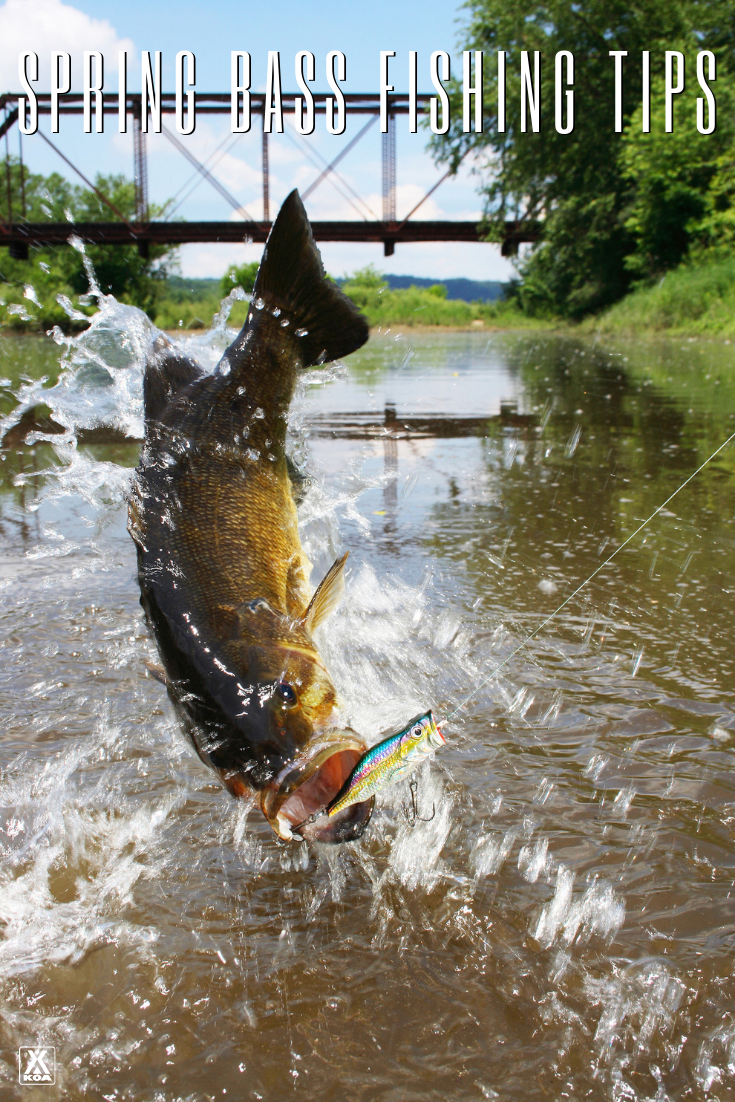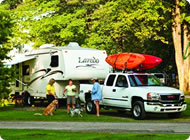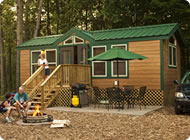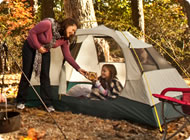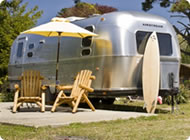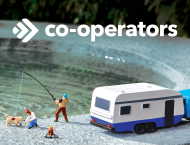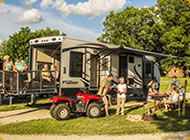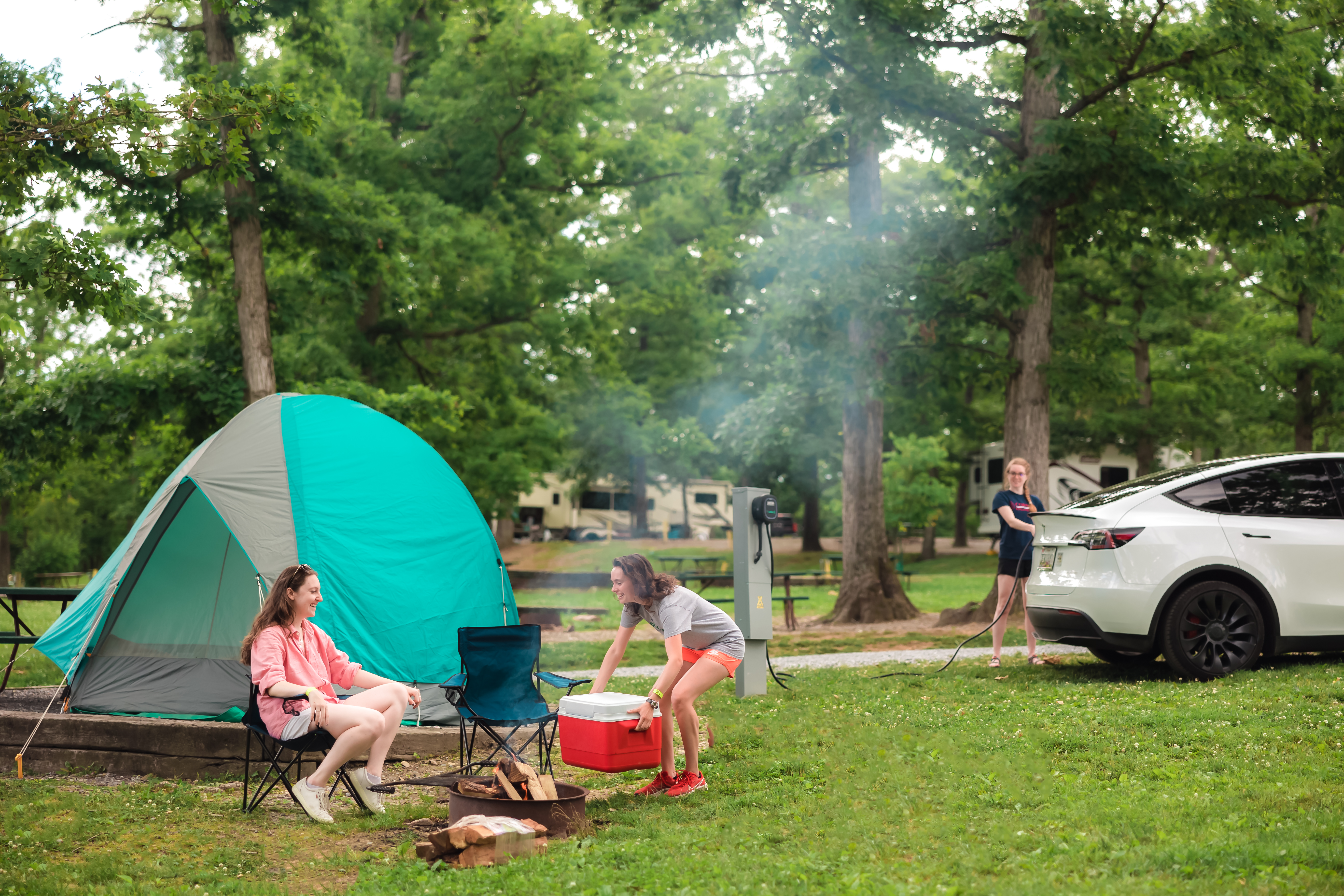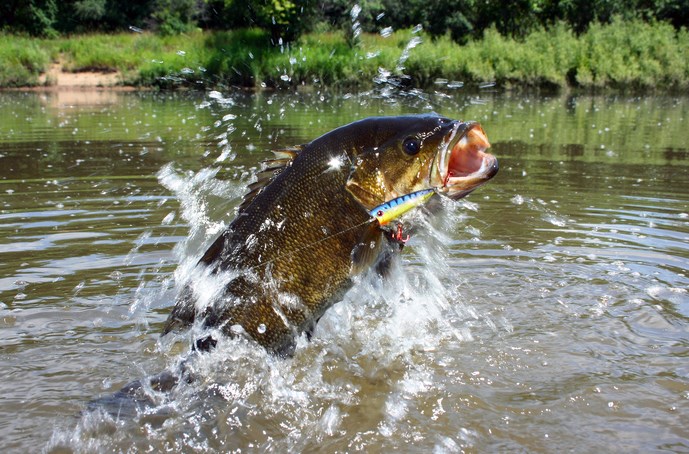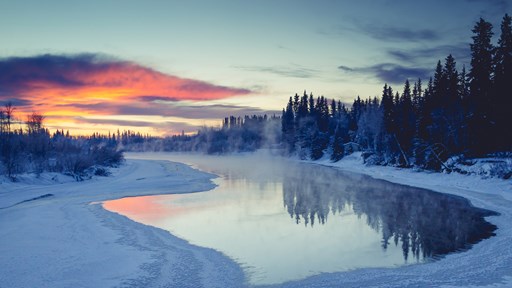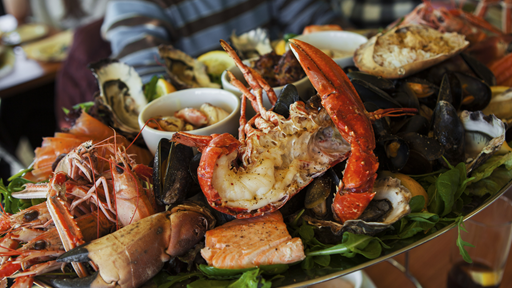Early Spring Bass Fishing Tips
Early spring can be both the most challenging and most rewarding season for bass fishing. As bass migrate from cold, deep waters to shallow, sunny flats, anglers must carefully track bass movement if they hope to get a bite — but when they do hook a fish, many more catches are likely to follow. Large bass are also at their most vulnerable during the pre-spawn season, so if you are willing to venture into the cool and muddy spring waters, you may be lucky enough to catch your biggest bass of the entire fishing season.
In this article, we will help you fill your tackle box with the best early season bass lures and offer spring bass fishing techniques for a successful spring fishing trip.
How to Locate Bass in the Spring
The most critical step for spring bass fishing success is finding the spot where bass are biting. During the pre-spawn season, bass migrate from their wintering areas in deep waters to shallow flats where they will lay their eggs. Bass tend to follow similar migration patterns whether they are in a lake, pond, river or creek. The fish will follow underwater canals, ditches and ridges as they move towards the shallows. Depending on the size of the body of water, these migration routes can be a few dozen yards to over a mile.
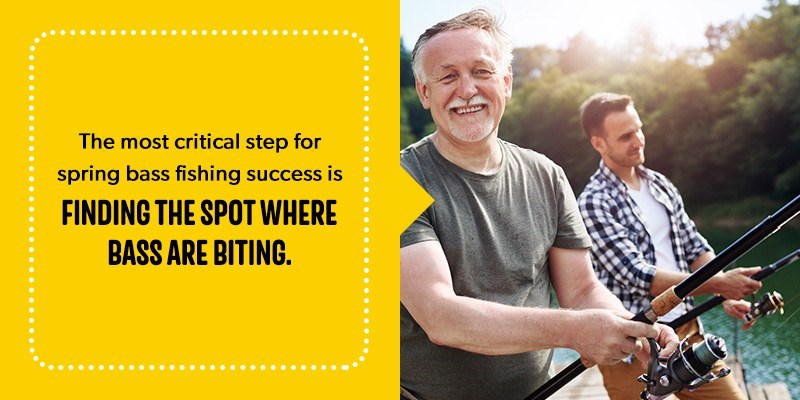
Finding the bass migration route in the body of water you are fishing is key for successful spring bass fishing. As bass make their way to the shallows, they will linger in spots along points and ridges, especially where flat shallows meet steep drop-offs. Migrating bass can also be found around rocky areas, emergent grasses, docks and fallen trees. These are often the best places to hook bass in early spring.
As the temperature and weather change throughout the day, bass may move between areas of the lake or up and down in the water column. Even for seasoned anglers, locating bass in early spring can be a challenge, but it can certainly pay off. As bass emerge from the inactive winter season and prepare for spawning, they begin to feed heavily and will strike quickly at well-presented bait. By keeping a variety of bait and lure in your tackle box and paying attention to bass movement, you can fill your boat with bass in no time.
Early Spring Bass Fishing Lures and Baits
The best early spring bass fishing lures are those that can cover plenty of water and have a fairly steady presentation. Bait that allows a long cast is essential for locating bass — especially in larger lakes and rivers. Lures with a steady and slow presentation will typically be more effective for bass that are still moving slowly in the cooler water.
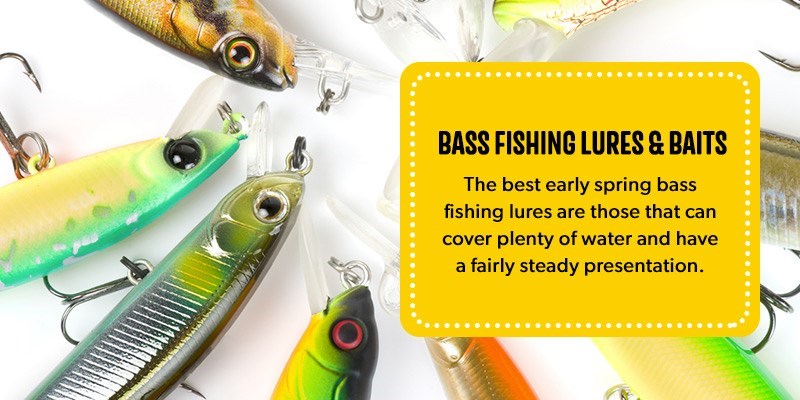
However, early season bass fishing requires versatility to keep up with the unpredictable spring weather and the movement of the fish. On warmer spring days, faster bait with more active presentation may win more bites.
When choosing early season bass lures, fill your tackle box with a variety of baits and lures for success in any situation. Once you have located the bass and considered the weather conditions, you can choose the right lure to reel them in. Here are some of the best early spring bass fishing lures to try this season:
1. Suspending Jerkbaits
Suspending jerkbaits imitate baitfish that are dying or chilled from the winter, making them an excellent choice for colder days. Jerkbaits can be reeled in slowly with subtle jerks and wiggles to attract slow-moving spring bass as they transition from their wintering areas. Suspending jerkbaits can also be held in the strike zone for a long time so sluggish bass have a chance to bite.
Suspending jerkbaits are most effective over points, ridges and humps that are close to deeper water and adjacent to spawning areas. Bass in these areas will not aggressively chase prey, but will quickly bite when an easy meal is presented. For this reason, suspending jerkbaits are even more useful in clear water when bass can easily spot them.
Each suspending jerkbait will have its own unique movement, so pack a few different types for your spring bass fishing trip. On very cold spring days, suspending jerkbaits with a subtle rolling motion may be the best choice. On warmer days, jerkbaits with a more active wiggle may be more effective.
2. Lipless Crankbaits
Like suspending jerkbaits, lipless crankbaits also resemble winter-chilled baitfish and are another great choice for early season bass lures. Lipless crankbaits are best for lakes with emergent grasses as they can be pulled above the top of the vegetation to draw strikes from bass sheltering in the grasses. This versatile bait can also be used along points and the edges of deep channels. Allowing long casts, lipless crankbaits are perfect for covering a lot of water when locating bass.
Lipless crankbaits present a tight wiggle and produce vibrations and sound, making them easy for slow bass to track and strike. Choosing a lipless crankbait in bright red or shiny chrome can draw even more bites from bass in the spring.
3. Jigbaits With Crawfish or Grub
On warmer spring days when bass have migrated to shallower areas, jigbaits can be used along docks or rocky spots. Jigs offer a slow presentation, can cover a lot of water and are effective at a range of depths.
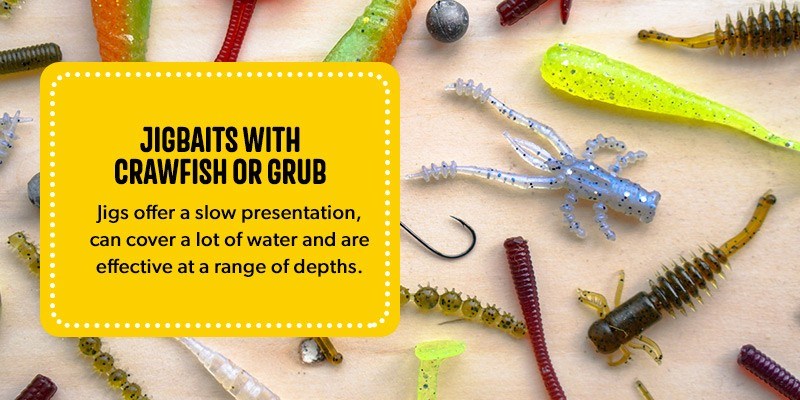
When the appetite of bass increases in the spring and they start to go after bigger prey, jigs with creature-like lures — such as crawfish and grub — are particularly effective. Smaller crawfish lures often work best in cold water, but if you are fishing an area with bigger bass, you can use a larger lure. The best color for a crawfish lure will depend on the clarity of the water — green works well for clear water, oranges and browns are effective in muddy water and blue or black is best for very dark water. If using a jigbait with a grub, choose a simple curly tail grub.
4. Plastic Worms
Small plastic worms, also called finesse worms, are a great choice for challenging fishing conditions. Finesse worms can be used on a variety of different rigs — including a drop-shot, shaky head or Carolina rig — to fish any area where bass are congregating. Finesse worms are particularly effective on shallow flats when bass come up to feed in sunny spots. When choosing plastic worms for spring bass fishing, look for ones that have a small profile and a fairly sturdy tail that does not flap a lot. Translucent colored finesse worms often have the most success for spring bass fishing.
5. Tubes
When you are locating bass in flats or along ridges, soft plastic tubes are a great choice. This simple-to-use bait can be held close to the bottom and dragged slowly along humps to cover a large area thoroughly and find where the bass are biting.
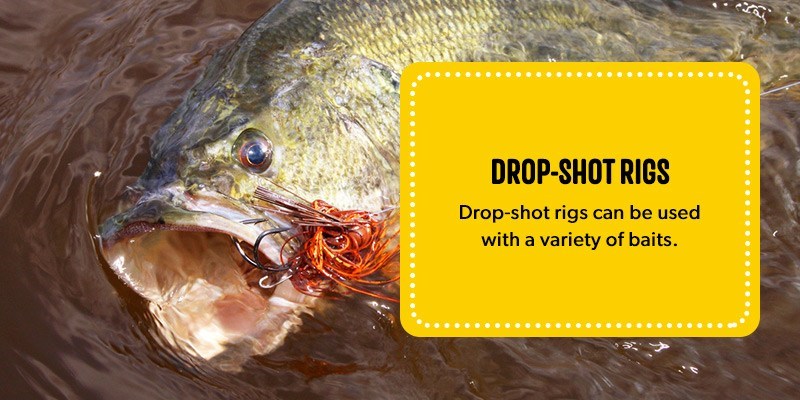
6. Drop-Shot Rigs
Drop-shot rigs are effective and extremely easy to fish with, making them an excellent choice for bass fishing with the whole family. These rigs have a weight at the bottom with a hook and bait tied above it so they can be lowered into areas where bass are congregating and pulled up to catch a bite. Drop-shot rigs can be used with a variety of baits — including crawfish and finesse worms — and can be fished anywhere from deep ridges to shallow flats.
Spring Bass Fishing Techniques
The most successful spring bass fishing techniques will often involve slow presentation with subtle jerks, as the fish are still moving slowly in the cooler water. However, each type of spring bass fishing lure also requires a particular technique to attract the most strikes. Here are some of the best spring bass fishing techniques for each type of bait:
1. Best Technique for Suspending Jerkbaits
When fishing for bass with a jerkbait, cast the lure over the top of the hump or ridge you are fishing. First, reel quickly to allow the bait to drop to its diving depth and then jerk the rod a few times. Pause the presentation so the lure becomes motionless and then jerk it a few more times. Continue this cadence of jerks and pauses as you pull in the line.
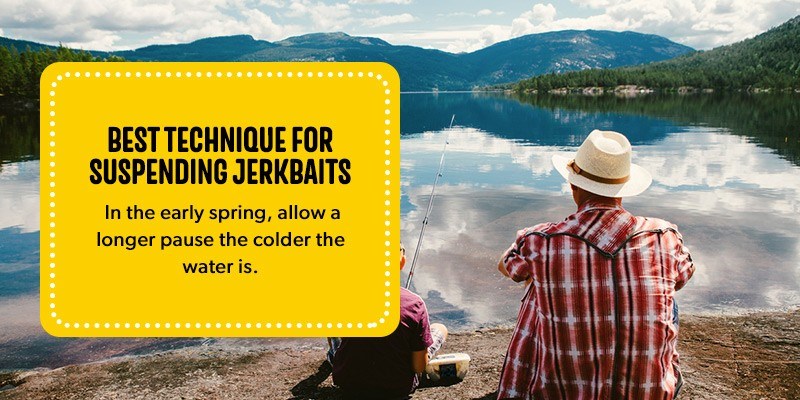
The cadence of the pulls, the length of the pause and how sharply you jerk the rod will determine how successful you are. In the early spring, allow a longer pause the colder the water is. Colder spring weather also calls for lighter and more infrequent jerks to mimic winter-chilled baitfish.
If you are not getting any bites using a jerkbait, change the cadence of the jerks or adjust the timing of the pause. Experiment with different patterns of jerks and pauses until you get a bite. Once you find the right rhythm, stick with it so you can repeat your results and reel in a few more big ones.
2. Best Technique for Lipless Crankbaits
One of the best techniques for spring bass fishing with a lipless crankbait is simply to cast a long distance and then reel in the lure continuously. Keep the bait along the top of the pond vegetation as you reel it in to draw strikes from bass sheltering in grasses.
After you cast, begin reeling immediately to prevent the bait from fluttering or falling as it drops. As you reel in the lure, adjust your rod positioning and speed to maintain the correct depth. If you cannot feel the grasses as you reel in the lipless crankbait, slow down your retrieve until the lure is just barely touching the vegetation. If you feel the lure dipping into the grass, speed up your retrieve and lift the tip of the rod to raise the lure.
If you do not get any bites with that technique, you can also try dropping the bait into the vegetation periodically and then pulling it back out with a flick of your wrist. Hungry bass will often strike as the crankbait emerges from the vegetation.
3. Best Technique for Jigbaits
Slow and low presentation is key for early season bass fishing with jigbaits. Allow the jigbait to sink entirely to the bottom and then keep it in contact with the bottom as you reel it in. Keep the tip of your rod down and drag the lure slowly along rocks or other habitats to give the bass plenty of time to bite. In colder spring weather, you may even choose to pause between drags, moving the lure just a few inches at a time.
If you are fishing a point along a channel, you can also drag the jigbait slowly along the ridge and then drop it into the channel to trigger a strike. Allowing your jigbait to make noise on wood and rocks can also attract attention from nearby bass.
4. Best Technique for Finesse Worms
Spring bass fishing with plastic worms requires a similar technique as jerkbaits with an emphasis on the pause. Cast out the finesse worm and allow it to sink to the bottom. Pull the lure a few inches and then let it rest. Keep tension in the line at all times so you can feel what is going on at the end. If you feel a strike or the line becomes slack as a fish picks it up and swims towards you, set the hook.
5. Best Technique for Tubes
When fishing with tubes, make a long cast along a ridge or hump and allow the tube to sink to the bottom. Drag it back in slowly with a continuous motion. If the wind allows, you can even cast the lure and then let the drifting of your boat to pull the bait for you — just remember to check the line for a fish every now and then or you may miss a big bite.
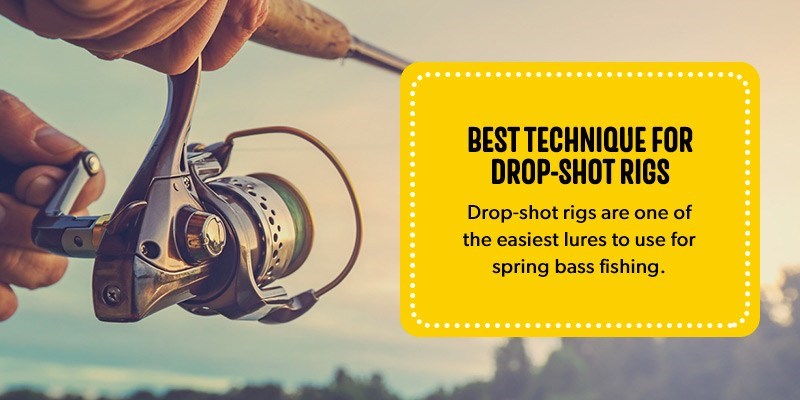
6. Best Technique for Drop-Shot Rigs
Drop-shot rigs are one of the easiest lures to use for spring bass fishing. Once you have found where the bass are congregated, just drop the line. Any aggressive fish will strike at the bait as it passes down. If no bass are biting, shake the line or hold it still for a moment to encourage a strike. To set the hook, pull the line up and reel it in. Drop-shot rigs are an excellent choice for spring bass fishing with children or for beginner anglers.
Six Additional Tips for Bass Fishing in Early Spring
Pairing the best early season bass lures with the best fishing techniques can hook a bass no matter where they are hiding. But in the fickle spring bass fishing season, a little extra help can never hurt. Here are a few more early spring bass fishing tips to set you up for success this season:
- Cast for repeat results: One of the best tips for early spring bass fishing success is to pay close attention to what works for you and what does not. Because bass behavior will change frequently with the fluctuating weather and temperature in spring, each day on the water may call for a different approach. Once you find a technique that wins you a bite, repeat the same cast and retrieve to catch a few more.
- Fish out the area: Bass will often congregate in the same areas in spring — meaning if you catch one, you may catch a dozen more in the same spot. After your first catch, continue to cast along the same ridge or point. If you do not get a second bite, try fishing the same area from different angles before moving to a new spot.
- Pay attention to water conditions: Fickle spring weather can make it challenging to locate bass, but by paying attention to the water conditions, you can find bass more quickly on each subsequent spring fishing trip. Once you find an area where bass are congregating, take a mental note of the water color, depth, temperature and bottom conditions. Consider the location of the ridge or point relative to channels and flats. These details will help you track down bass more quickly next time.
- Watch for birds: When fishing with jerkbaits or crankbaits, watch for areas where birds are diving to catch dying baitfish. These will often be spots where hungry bass are also congregating and where jerkbaits and crankbaits will be most effective.
- Use the wind to your advantage: On spring days when the water is clear, bass may see your bait too clearly and be wary of biting. Wind can help to disturb the surface of the water to attract bass better. If you are not getting any bites on a clear lake, try casting when the wind picks up.
- Fish the mudlines: If you are having trouble locating bass on a spring day, look for mudlines created by wind and waves. Bass will often hide along the edges of mudlines where they have the advantage over baitfish which are drawn there to feed on plankton. Using brightly colored lures, drag your line across a mudline from the muddy water into the clear water. Bass will often strike just as the bait emerges.
With the right techniques and a little bit of luck, you can reel in a big bass to start the season right.
The Best Places to Go Early Bass Fishing
Spring is a great time for bass fishing almost anywhere across the country. In warmer southern states, bass migration typically begins in March, while in colder northern regions it may not begin until mid-to-late April. However, the peak season for pre-spawn bass fishing can vary widely in different regions based on temperature patterns and weather conditions each year.
For serious anglers, these variations in bass migration make it possible to catch peak spring bass fishing in several different popular fishing locations across the U.S. all in one fishing season. Here are just a few of the best places for early spring bass fishing across the country:
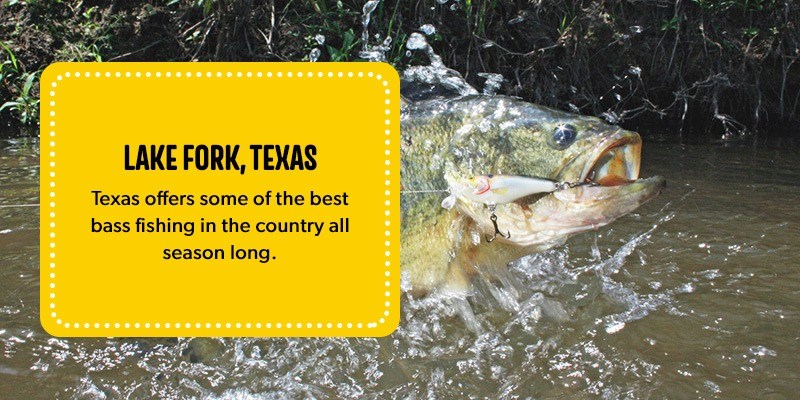
1. Lake Fork, Texas
Texas offers some of the best bass fishing in the country all season long, and Lake Fork is one of the state’s most popular bass fishing destinations. During spring bass migration, Lake Fork provides many grassy inlets, vegetation and other pockets where bass can congregate. The lake also offers thin and shallow sections of water that are perfect for hooking big bass on warm spring days.
2. Choke Canyon Reservoir, Texas
Another popular Texas bass fishing destination, Choke Canyon is located in south-central Texas on the Frio River. This fertile reservoir produces large bass that can be hooked from its shorelines or along offshore humps. Choke Canyon provides a variety of cover for migrating bass including timber, vegetation and rocks. The reservoir also offers various water conditions from its muddy upper end to its clear lower lake.
3. California Delta
California is another state known for excellent bass fishing. From coastal inlets to rivers and lakes, California has bass fishing waters to satisfy any angler. The California Delta where the Sacramento and San Joaquin rivers meet is a particularly productive region for bass fishing in California and includes rivers, tidal channels and bays. The thick grasses and vegetation in this region provide perfect cover for heavyweight bass in the spring and often make it easy to get a bite. However, the California Delta is also expansive with rising and falling tides that can sometimes make it challenging to locate bass.
4. Southern Lakes in California
Many lakes in Southern California have produced massive bass over the years — including Dottie, the famous 25-pound bass that was hooked in Dixon Lake in 2006. Castaic Lake and Lake Casitas, both situated just north of Los Angeles, have also been home to some of the biggest largemouth bass ever caught. Many Southern California lakes continue to produce some of the best bass fishing in the country, and early spring is the best season to try your hand at catching a big one.
5. Guntersville Lake, Alabama
Boasting a stable water level and ample public boat ramps, Guntersville Lake is a prime spring bass fishing destination for anglers of every skill level. Guntersville Lake offers many patches of eelgrass where hungry bass can hide in the spring.
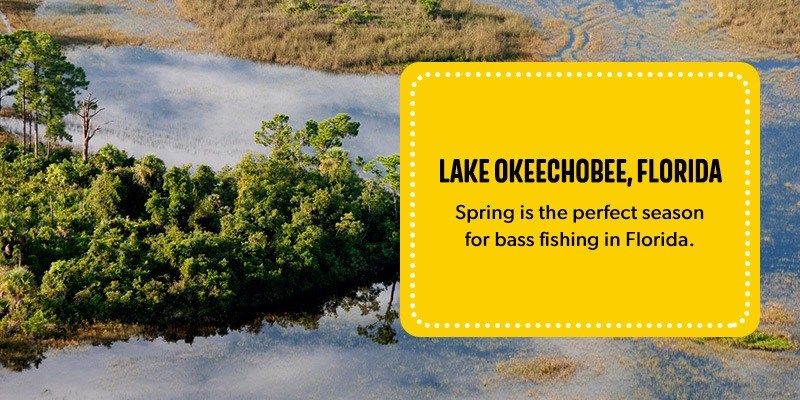
6. Lake Okeechobee, Florida
Spring is the perfect season for bass fishing in Florida, and Lake Okeechobee attracts anglers from across the country. Lake Okeechobee offers excellent habitat for migrating bass with lily pads, shallow waters and ample vegetation. A scenic trail encircling the lake also makes it easy to scope out the perfect bass fishing spot.
7. Lake Seminole, Georgia
Located on the southwestern border of Georgia, Lake Seminole offers nearly 400 miles of shorelines that are filled with bass in the spring. Rocks, grasses, logs and bushes along pockets of deep water provide cover for migrating bass.
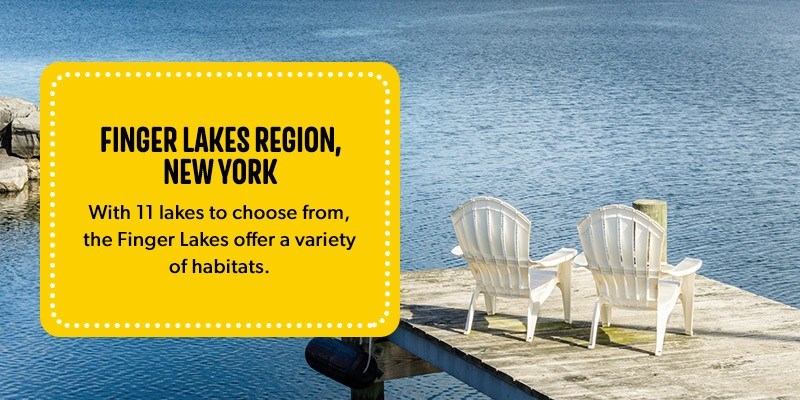
8. Finger Lakes Region, New York
New York’s Finger Lakes offer some of the best fishing in the state for everything from bass to trout to salmon. With 11 lakes to choose from, the Finger Lakes offer a variety of habitats from weedy shallows to deep ridges where anglers can hook bass all season long.
Use KOA Campgrounds as Your Home Base for Spring Bass Fishing
With the right spring bass fishing techniques and early season bass lures, you can fill your boat with bass no matter where your spring fishing trip takes you. If you are ready to plan a trip to your favorite bass fishing waters, consider choosing a KOA Campground as your home base. With more than 500 locations across the U.S. and Canada, you can find a KOA Campground anywhere you dream of hooking a bass this spring.
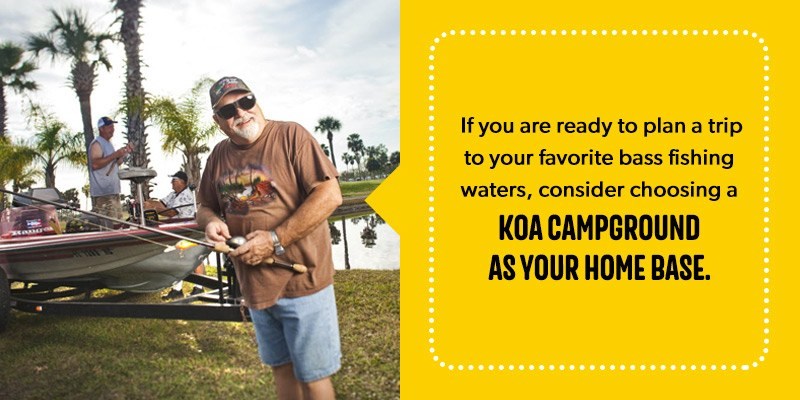
KOA Campgrounds offer a variety of ways to stay for campers and anglers of every style. Enjoy a comfortable KOA Cabin or KOA Deluxe Cabin after a long day spent wrangling bass or stay closer to nature with a traditional KOA Tent Site. KOA Campgrounds also offer convenient Pull-Thru and Back-In RV sites available with full-hookups.
When you stay at a KOA Campground for your spring fishing trip, you can expect friendly and knowledgeable staff, clean bathroom and shower facilities, level and clean campsites, laundry facilities and other standard amenities to make your visit comfortable. For even more fun for the whole family, many KOA locations also offer special features like playgrounds, pet parks, swimming pools, game rooms, water sports and more. If you can’t wait to hit the water for spring bass fishing this season, make your reservation at a KOA Campground today.
